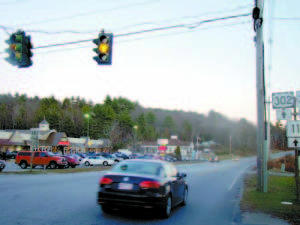Stoplight won’t go green; residents go green

THE TRAFFIC SIGNAL on Roosevelt Trail at the Route 35 junction offers drivers an orange blinking light — caution — as a nearly full moon rises in the east. (De Busk Photo)
By Dawn De Busk
Staff Writer
NAPLES — There is a little less green when the tourists leave.
It seems that rule applies to the traffic stoplight on Roosevelt Trail.
A few weeks ago, the green signal quit lighting up. So did the red signal. In recent weeks, the stoplight stopped changing colors altogether and has been operating in orange blinking mode.
“It is broken,†Naples Town Manager Ephrem Paraschak said on Monday. “When it has a problem, it automatically defaults to a blinking light,†Paraschak said. “It’s good it is not the Fourth of July,†he said.
With sparser traffic on the road than in the summer months, the need to get the traffic light fixed is not dire. But, help is on the way, Paraschak said. “There is a specialized company that is coming to fix it,†he said, adding hopefully that will be done before the holiday.
“The electricians don’t know what is wrong. So, we called a company that specializes†in traffic signals, he said. “The stoplight is old. It was put in when the Madison Heights neighborhood went in,†he said, adding that happened in the 1980’s.
While the town’s traffic signal might be experiencing a green deficit, some green ideas have surfaced during recent Naples Board of Selectmen meetings.
Plans are in the making to put an electric car charger in the Naples Village Green area.
According to Paraschak during a meeting on Nov. 16, the most agreed-upon location for the electric car charger is the parking space next to the little brick building. The brick building once served as the town office; and for the past three years, the Maine Antique Bottle and Glass Museum has occupied the building.
According to Dick Meyer, who is a member of the Naples Conservation Commission, anyone with an electric car or hybrid vehicle also has an application that locates every charging station along their traveled route.
Having an electric car charger in town will increase the likelihood of a percentage of travelers stopping in Naples for some duration. After all, it could take three to four hours for the battery of an electric car to be recharged, Meyers said.
“While charging, hopefully, they will be spending money,†said Larry Anton, who accompanied Meyers.
One big plus is that the cost to the town is expected to be minimal, Paraschak said. There are grants available from Greater Portland Council of Governments (GPCOG) for electric car charging stations, he said.
After speaking with staff from GPCOG, Paraschak said there is no commitment yet. “The grant would cover the cost of the charging station and the installation of the unit. But, the town pays for the electricity,†Paraschak said. “I suspect we would get more use than the Town of Casco,†he said.
Even though the Causeway would be a more visible location, parking spots are highly-coveted during the summer months, Paraschak said.
“We didn’t want to tie up a Causeway parking spot,†Anton said.
Paraschak said another drawback to putting an electric car charger on the Causeway is that the town does not maintain the sidewalks during the winter. The future electric car charger should be “somewhere where you could use it in the winter,†he said.
Chairman Bob Caron II said the old town office location “is a good area. It’s lit up, next to the church.â€
Plus, the space is subject to snow removal.
Last year, GPCOG loaned a hybrid electric vehicle to municipalities; and Naples was one of the towns that conducted a test drive.
Paraschak said he would invite GPCOG representatives to a future meeting to answer any questions the selectmen might have about the car charging stations as well as what costs are involved and what costs are covered by the grant.

